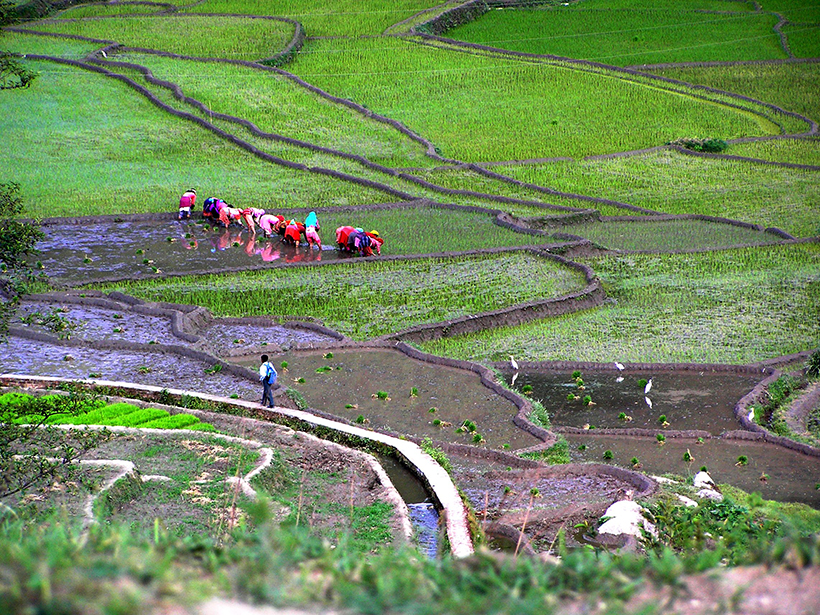Faced with increasing climate uncertainty, scientists maintain that it is essential to develop a regional data-sharing mechanism.
The Intergovernmental Panel on Climate Change has identified the Himalayan region as a “white spot”—a place devoid of meaningful data—because of the lack of climate and impacts information. Both the sparsity of measurements and lack of long-term continuity of hydrologic and climatic observations contribute to data gaps in the Himalayan region. Faced with increasing climate uncertainty in the region, scientists maintain that it is essential to develop a regional data-sharing mechanism to guide collective mitigation and adaptation efforts.
To this end, scientists from 27 countries and multiple disciplines gathered in Kathmandu, Nepal, in January 2015 for the International Conference on Climate Change Innovation and Resilience for Sustainable Livelihood. Participants agreed that the scarcity of long-term data sets could be partly addressed by a common regional data portal, which would also focus on quality assurance. They also identified better communication and information dissemination as goals at the conference.
Data Access for All

Discussion focused on how community planners need to have access to data pertinent to their fields to make informed decisions about factors such as weather hazards, flood and drought events, and the potential for disease outbreaks. In Nepal and elsewhere, many research projects have been generating scattered field data that could be made available through a common data portal that would also integrate geospatial and remote sensing information.
The biggest challenge, attendees agreed, is to provide this information to stakeholders in an understandable form. Stakeholders include farmers and herders, nonprofits and development organizations, and many other users with different expectations and levels of sophistication. As a start, the Nepal government has launched a data portal for sharing climate observations.
The conference featured sessions on climate extremes, water resource management, the livelihood of women and marginal groups, and policy needs for agriculture and livestock sectors. Two dedicated sessions on data gaps and potential remedies identified a pervasive inability of regional institutions to disseminate information at local and policy levels. Examples of applications discussed included early flood warning for communities and monsoon timing and intensity prediction for farmers.
Untapped Potential of Indigenous Knowledge
Tested traditional knowledge can be integrated with scientific findings for promoting sustainable livelihoods.
The participants also emphasized the importance of tapping and applying indigenous knowledge while also exploring innovative ideas. Tested traditional knowledge can be integrated with scientific findings for promoting sustainable livelihoods.
For example, heat energy tapped from farm manure to warm the water for household use in Nepal’s Dhading District reduces wood consumed for fuel, thereby conserving forest. How can this be employed more broadly to conserve resources?
An Integrated Approach
Speakers presented several case studies from the region in which community action plans and training were combined with hydroclimatic monitoring and data visualization to tackle problems such as the shortage of water for drinking and agriculture, the lack of market access, poor-quality housing, recurrent erosion and landslides, and urban water contamination and the “heat island effect” whereby the heat of municipal areas creates an urban-driven warmer climate.
Attendees agreed that the ability for such approaches to scale up and be replicated should also be considered.
Action Items
Expert panelists concluded the conference by spelling out the following clear ways to better tackle climate-related problems in the Himalayas:
- Include community-level knowledge.
- Translate research findings into user-friendly forms for effective application.
- Connect and collaborate with all stakeholders in both the private and public sectors.
- Build a collaborative data exchange platform.
- Organize a consortium for high-altitude observations including cryospheric changes.
The program agenda, presenter list, abstracts, presentation slides, posters, and some videos can be found on the conference website. Madan Lall Shrestha and Dilli Bhattarai from The Small Earth Nepal (SEN) also contributed to this meeting report.
—Jeeban Panthi, The Small Earth Nepal, Kathmandu, Nepal; email: [email protected]; Nir Y. Krakauer, City College of New York, New York, N. Y.; and Soni M. Pradhanang, University of Rhode Island, Kingston
Citation: Panthi, J., N. Y. Krakauer, and S. M. Pradhanang (2015), Sharing climate information in the Himalayas, Eos, 96, doi:10.1029/2015EO033827. Published on 5 August 2015.
Text © 2015. The authors. CC BY-NC 3.0
Except where otherwise noted, images are subject to copyright. Any reuse without express permission from the copyright owner is prohibited.

